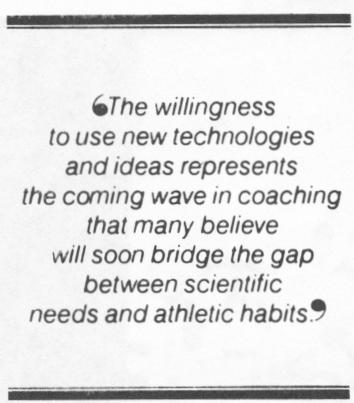| Previous | Index |
![]()
"Them am no spats that I know of where you are really cognitively involved. Them are no thinking sports. Sports are fluid motion, muscle memory The proper response has to come from muscle memory because Lord help you if you try to think about anything athletic." Clein probes the body for its information storage-and-retrieval potential much as a neurologist probes the nerves. Clein links athletes to a host of measuring systems with electrodes, noting the range of muscle-nerve responses as the athletes make athletic choices.
Bielski takes a slightly different position. "The ability to switch from the fluid state to the cognitive and vice versa is where the real power lies." he says. "This is what separates the supple, successful Roger Staubach-type athlete from the stiff Duane Bobick-type. The power of switching marks the great performer. The ability to alter the game plan by quick-thinking strategy as well as by recalling a learned repertoire of techniques. To follow rushes of confidence with the knowledge of when to stop and ask. What am I doing? What is my opponent doing? What is going on in this situation? All without ever losing sight of the point. successful performance
Even the physical side of sports science will have a positive mental impact on athletes. New training systems that achieve better conditioning for athletes also generate enormous confidence because of their scientific precision and efficiency The athletes are not simply in better shape. they know they're in better shape, and so they perform without worry
Ariel's Wilson-Ariel 4000, which the Dallas Cowboys will use this season, actually
puts the computer in charge of the player's training. Ariel's unit monitors hydraulic lifts that function like barbells. except that their pressure can be fine-tuned to maximize a player's workout. A physical profile cassette is made for each athlete, relating his
strengths. weaknesses. body peculiarities. and fitness goals The computer uses this profile to adjust the pressure. speed, and duration of the 4000's drills It can. for instance. help an athlete build up a postsurgical knee by presenting it with the most appropriate amount of pressure each day. while keeping the other leg from going soft by challenging it with the full training weight This individual programming. Ariel
asserts, cuts down on training time. gives the athlete confidence in his training regimen, and allows coaches to train each part of an athlete's body to absolute specifications for his particular task
"The 4000 gives you a lot more information." Ariel says. "and it tells you how you re progressing It will let you know if you re lazy or it you should try harder It'll even remind you if you haven't paid your gym dues for the month
The Hilton hotel chain. Ariel claims. is thinking about putting 4000's in all its health clubs so that travelers can get perfect workouts through their computer cas settes. nomatter where they may be
The next boo *a envisioned by Ariet, will be three-dimensional computer simulations of athletic motion. Not exactly holograms, these images wilt be 3-D views projected on a two-dimensional screen. Like computer-generated engineering perspectives, they will give the illusion of three-dimensionality.
"By using a hologram. you'd really see the figure in 3-D utilizing optical prisms and things like that." Ariel says 'And we will see that in the near future. no question about it You'll be able to step right into a hologram to simulate the movements of an Olympic champion. We are working on that now"
Ariel's work may represent sports' next destination, but quite a few trainers and athletes haven't gotten there yet. They prefer training techniques that. while new aren't as far out as prancing stick figures. The most popular among these is the Cybex machine. a spin-off from Skylab that has found wide acceptance with professional basketball and football teams
OMNI July 1980

![]()
| Previous | Index |